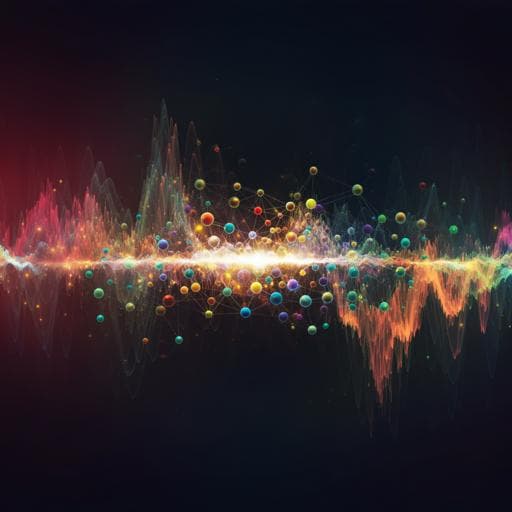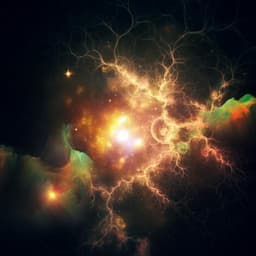
Computer Science
Biophysical neural adaptation mechanisms enable artificial neural networks to capture dynamic retinal computation
S. Idrees, M. B. Manookin, et al.
Discover groundbreaking advancements in artificial neural networks with a new deep learning model that enhances the predictive capabilities of retinal responses. This promising research, conducted by Saad Idrees, Michael B. Manookin, Fred Rieke, Greg D. Field, and Joel Zylberberg, emphasizes the importance of neural adaptation in accurately interpreting dynamic visual environments.
~3 min • Beginner • English
Introduction
Artificial neural networks have been effective in modeling neural responses under controlled conditions and static statistics, including in computer vision tasks and in predicting responses in visual cortex and retina. However, their typical use of static nonlinearities limits dynamic adaptation to changing input statistics common in naturalistic sensory environments. Adaptation is pervasive in sensory systems, including the visual system where photoreceptors and downstream circuitry adjust sensitivity and kinetics over milliseconds to hours to match large fluctuations in light intensity. Phototransduction in photoreceptors can adapt rapidly, controlling sensitivity and response kinetics as light is converted into electrical signals. The authors ask whether embedding biophysical adaptation mechanisms in ANNs improves prediction of retinal ganglion cell (RGC) responses under dynamic and out-of-distribution conditions. They develop a CNN-based retina model that incorporates a front-end photoreceptor layer implementing a biophysical phototransduction model and test whether this improves prediction of RGC responses to naturalistic stimuli and across large changes in mean light level.
Literature Review
Prior work shows deep learning (e.g., CNNs) can predict neural responses in V1 and retina and provide insights into neural computation, but generalization to naturalistic, dynamically varying inputs remains unclear. Sensory adaptation is well-established across modalities, including odor and auditory processing, and critically in the retina, where adaptation spans multiple timescales and orders of magnitude in light intensity. Biophysical models of phototransduction and adaptation exist, capturing dynamics via cGMP turnover, phosphodiesterase activity, and calcium-dependent feedback, and have been validated in rod and cone recordings. Earlier retina models (e.g., Deep Retina) capture many aspects of RGC responses but lack explicit adaptive mechanisms at the input stage. The authors leverage this literature to propose a hybrid approach combining biophysically grounded adaptation with trainable CNNs, hypothesizing improved predictive performance and generalization, particularly under changes in local and global luminance.
Methodology
Data: Ex vivo primate retina recordings to naturalistic movies and checkerboard white noise at a mean luminance of 50 R*receptor−1 s−1 (rod-dominated). For cross–light-level tests, primate RGCs were recorded at three mean light levels (30, 3, 0.3 R*receptor−1 s−1). For extreme generalization, previously published rat RGC recordings were used at photopic (10,000 R*receptor−1 s−1, cone-dominated) and scotopic (1 R*receptor−1 s−1, rod-dominated) levels. RGC spikes were binned at 8 ms, smoothed, and normalized. Movies were upsampled to 120 Hz (8 ms/frame). Reliability indices and explainable variance were computed from repeated trials.
Models: (1) Conventional CNN similar to Deep Retina: three convolutional layers with BatchNorm and rectification, max pooling, followed by a fully connected layer with softplus output, predicting instantaneous RGC spike rates. Layer Normalization (per-pixel over time within each 80- or 120-frame segment) at the input removed mean luminance. Inputs were sliding windows (e.g., 80 frames for naturalistic experiments, 120 for cross–light-level tests). Hyperparameters (layers, channels, kernel sizes) were optimized via grid search.
(2) Photoreceptor-CNN: A front-end neural network layer implements a biophysical phototransduction model (six ODEs, 12 parameters) capturing feedforward and Ca2+-mediated feedback mechanisms governing cGMP turnover and cGMP-gated channels. Parameters were initialized to experimentally measured rod or cone values; 5 parameters (photopigment decay α, PDE activation η, PDE decay δ, Ca2+ extrusion β, and a sensitivity parameter γ) could be trainable; others were typically fixed. The layer transforms per-pixel light intensity (R*receptor−1 s−1) into photocurrents (pA) via Euler integration over the input segment (first 20–60 frames truncated to mitigate edge effects). LayerNorm follows the photoreceptor layer to stabilize training. Photoreceptor parameters were shared across pixels. The photocurrent movie then feeds the downstream CNN, trained end-to-end by backpropagation.
(3) Linear photoreceptor-CNN: The biophysical layer was replaced with an empirical linear photoreceptor filter (parameters initialized from single-photon response estimates and set trainable), lacking dynamic adaptation; a single gain parameter adjusts sensitivity.
Training and evaluation: Two-stage training for naturalistic experiments: pretrain on 36 min of white noise, then fine-tune on 8 of 9 naturalistic movies; test on a held-out 6 s movie. For cross–light-level primate experiments, train on high and medium light levels (40 min total) and test on held-out segments at high, medium, and the untrained low level. For rat extreme generalization, photoreceptor-CNN was trained on Retina A photopic data to learn cone parameters and inner-retina CNN; then retrained at scotopic level with CNN fixed to learn rod parameters; finally evaluated on Retina B photopic (to fit inner layers) and tested at scotopic on Retina B using learned rod parameters (transfer protocol). Optimization used Adam with Poisson negative log-likelihood, L2 weight decay on layers, and L1 penalty on outputs. Learning rate scheduling reduced LR at predefined epochs. Performance was quantified by Fraction of Explainable Variance Explained (FEV), with medians and 95% confidence intervals across cells, and paired two-sided Wilcoxon signed-rank tests for comparisons. Model receptive fields and response latencies were estimated from gradients of outputs w.r.t. inputs and compared to reverse-correlation STAs.
Key Findings
- Incorporating a biophysical photoreceptor adaptation layer significantly improved prediction of primate RGC responses to naturalistic movies with dynamic local intensity changes: example cell FEV improved from 59% (conventional CNN) to 71% (trainable photoreceptor-CNN) and 69% (fixed photoreceptor parameters). Across 57 cells, median FEV increased from 38% ± 8% (conventional) to 49% ± 15% (photoreceptor-CNN), a ~29% relative gain (p = 0.002).
- The improvement is attributable to nonlinear adaptive mechanisms: replacing the biophysical layer with a linear photoreceptor model yielded performance similar to the conventional CNN (37% ± 12% vs 38% ± 7%; p = 0.26). A photoreceptor-CNN with fixed, experimentally fit rod parameters performed comparably to the trainable photoreceptor-CNN (49% ± 10% vs 49% ± 15%; p = 0.07).
- Generalization across global light levels (train on 30 and 3 R*receptor−1 s−1; test on 0.3 R*receptor−1 s−1): the conventional CNN generalized poorly (median FEV 24% ± 15%), whereas the photoreceptor-CNN achieved 54% ± 11% (significantly higher; text reports p = 5×108). At trained light levels, both models performed similarly well (e.g., conventional: 84% ± 11% high, 78% ± 3% medium; photoreceptor-CNN similar medians).
- Across all train-test light-level combinations, photoreceptor-CNN outperformed conventional CNN on extrapolation tasks; the smallest difference occurred for interpolation to the intermediate (medium) level (p = 0.83).
- The photoreceptor layer enabled the model to capture light-level–dependent changes in response kinetics: model temporal receptive fields (from gradients) showed significantly shorter latencies at higher light levels, matching experimental reverse-correlation estimates (p = 2×10−4 for data; p = 1×10−4 for photoreceptor-CNN), whereas the conventional CNN showed no latency shift.
- Extreme generalization (rat; train at photopic 10,000 R*receptor−1 s−1): conventional CNN failed catastrophically at scotopic 1 R*receptor−1 s−1 (median FEV −52% ± 9%; N = 55), while photoreceptor-CNN achieved 54% ± 8% with only photoreceptor parameters switched from cone to rod (inner CNN unchanged). At photopic test level both models performed similarly (median FEV ~87% ± 5–6%).
- Parameter-efficiency: Gains were not due to increased capacity; in fact, photoreceptor-CNN had fewer total parameters (538,107) than the separately optimized conventional CNN (873,642). The photoreceptor layer adds only 12 biologically interpretable parameters.
Discussion
Embedding a biophysical phototransduction mechanism as the front-end of a CNN introduces an inductive bias that confers dynamic adaptation to changing input statistics, improving prediction of RGC responses in conditions with rapid local intensity fluctuations and enabling robust out-of-distribution generalization across global light levels. The biophysical photoreceptor layer directly models sensitivity and kinetic changes via cGMP turnover and calcium feedback, allowing the downstream CNN to operate on appropriately adapted signals. The failure of a linearized photoreceptor model to confer similar gains underscores the importance of nonlinear adaptation. The approach demonstrates how integrating biologically grounded dynamics into ANN architectures can bridge gaps between performance optimization and mechanistic interpretability. Moreover, because the photoreceptor layer parameters map to physiology and can be fixed to experimental values without losing performance, the models can help disentangle photoreceptor versus downstream circuit contributions to retinal computations. The findings suggest broader utility of such hybrid models for investigating adaptive neural processing and for improving generalization in neural system modeling.
Conclusion
This study introduces a photoreceptor-CNN that integrates a biophysical phototransduction layer with conventional CNNs, enabling adaptive changes in sensitivity and kinetics and yielding superior predictions of RGC activity under dynamic naturalistic stimuli and across large changes in ambient illumination. The model generalizes across light levels, including extreme photopic-to-scotopic shifts, with only photoreceptor parameters swapped, highlighting the central role of front-end adaptation. Contributions include: (1) a trainable or fixed biophysical layer with interpretable parameters; (2) empirical demonstration that nonlinear adaptation mechanisms improve ANN predictions and out-of-distribution generalization; (3) tools to analyze model kinetics matching experimental receptive fields. Future directions include adding downstream adaptive mechanisms (e.g., adaptive recurrent units to model spike frequency adaptation), incorporating adaptive gain-control layers to capture bipolar/amacrine adaptation, relaxing LayerNorm reliance while maintaining stability, learning spatially varying photoreceptor parameters, and extending the framework to cortex and clinical applications such as visual prosthetics.
Limitations
- The model still underperforms on naturalistic stimuli compared to white noise despite improvements, potentially due to limited naturalistic training data and absence of downstream adaptive mechanisms (e.g., spike frequency adaptation in RGCs, adaptive bipolar/amacrine circuitry, gap junction modulation, subunit rectification).
- Layer Normalization at the CNN input remains necessary for optimization stability and may partially compensate for sensitivity changes that could otherwise be managed by the photoreceptor layer, potentially reducing biological fidelity.
- Photoreceptor parameters are shared across all pixels (no spatial variability), and the model does not include explicit interactions among photoreceptors (e.g., coupling).
- The CNN stages are generic and may not capture detailed inner retinal circuit structure; downstream adaptation is not explicitly modeled.
- While a linear photoreceptor model underperforms, other empirical or recurrent architectures might capture some adaptation but would increase parameter count and data requirements; comparative evaluation beyond those tested is limited.
Related Publications
Explore these studies to deepen your understanding of the subject.







